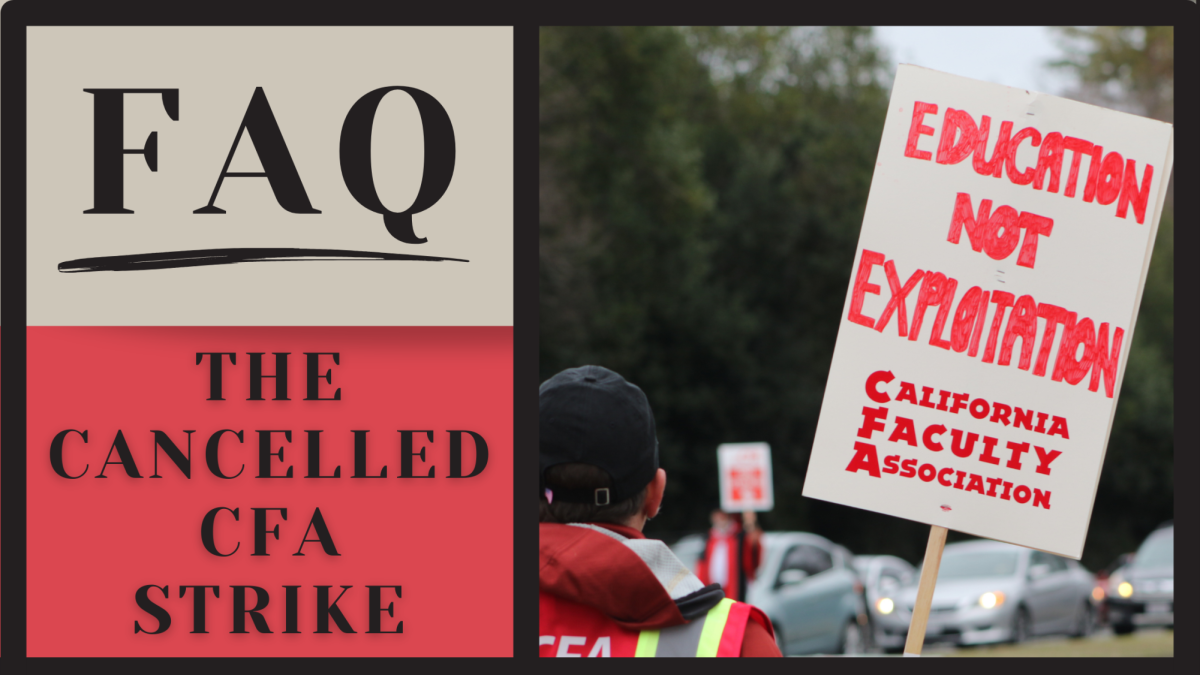With the weeklong California Faculty Association strike ending after only one day, it’s understandable for people to have questions as classes resume.
Here are some FAQs with information about the how and why the strike ended, how it is impacting classes and the tentative agreement between California State University and the CFA.
Question: Why did the CFA strike happen in the first place?
Answer: Some of the reasons CFA members cited are: increasing lecturer pay to “raise the floor,” increased paid parental leave, workload adjustments and a raise to set a minimum level of compensation keeping pace with increased inflation and cost of living.
The CFA claims that 20 minutes into their first round of negotiations the CSU’s management bargaining team threatened layoffs, walked out, canceled the three remaining days of planned negotiations and imposed a last, best and final contract offer.
Q: Why did the strike end so abruptly?
A: The CFA negotiators and leadership received the current offer late Monday afternoon and voted on whether to accept it as a tentative agreement or continue the labor action in hopes of a better offer. They had those votes Monday evening.
Once there is an offered contract, members are given the choice to either ratify or reject the offer. The offer was accepted by the negotiators and the strike ended. The union members returned to work Tuesday.
RELATED: BREAKING: California Faculty Association reaches tentative agreement with CSU
Q: What if I need to add/drop classes what does that timetable look like now?
A: In a statement released from the Office of Interim Vice Provost for Student Academic Success David Zeigler, the timetables for adding and dropping classes this semester were updated to extend the deadlines.
Zeigler said that for the first two weeks of the semester, adding courses can only be done by getting an instructor’s consent and using the add form throughOnBase. Dropping can be completed through MySacState without instructor permission.
During week three, an add/drop petition requires instructor’s consent. For the fourth week, the add/drop requirements are the same as week three, but will need the department chair’s signature.
Q: What concessions did the CFA get in the tentative agreement that were not in the CSU’s last best offer?
A: According to infographics released by the CFA on its Instagram, the major concessions in the new contract were raising the floor of the base salaries by at least 15.1% and establishing a counselor-to-student ratio of 1500-to-1.
Other changes between the proposals are: an increase in parental leave to 10 weeks, a 5% salary increase retroactive back to July 1, 2023 with another 5% increase contingent on CSU state funding not being cut for the 2024-25 academic year, gender-inclusive bathrooms and improved access to lactation spaces. The tentative agreement amends and extends the current contract by only one year.
Q: When will the vote on the new contract take place?
A: According to the CFA’s FAQ article “the dates for ratification are not decided yet, and we will update this document when dates are determined. The election to ratify will happen electronically. A simple majority prevails.”
Q: Do the union members have to vote to accept this contract? If the union members don’t accept the contract, are more strikes a possibility?
A: It’s a possibility that the members of the union could vote to reject the contract. Alternatively, there’s no guarantee that they could secure a better deal from the CSU by returning to the picket line.
If the union membership fails to ratify the contract, further strikes are a possibility.
Q: Does the CFA have a strike fund to compensate instructors for lost wages due to the labor stoppage?
A: No, while the Teamsters have a national fund to assist striking members, according to the CFA website, it does not have a strike fund to assist members during labor disputes.

























































































































